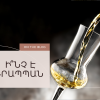Grappa's story is said to have its roots in a metaphysical alchemical quest for earth, fire, water, and air along with the classical element. The Greeks called that element ether, or pure, and assumed it was the liquid of the part of the universe where the Gods lived.
This drink was primarily made from the distillation of wine and first appeared when the Italians turned their attention to the skins and seeds left over from crushing grapes for wine. This is how Grappa , beloved by many of us, was born.
The exact date of Grappa's emergence is unknown. However, it originated in the Middle East in the 8th century and then moved to Europe in the 1100s.
Some written accounts from the 14th century attribute the origin of the drink to the foothills of the Italian Alps and the northern regions of Trentino-Alto Adige and Val d'Aosta. At the end of the 15th century, Grappa production was licensed. Early distillers made spirits by heating wine, hence the word "brandy" from the term "burnt wine." And in the 16th century, the distillation of mash made from grain was mastered.
Renaissance and Grappa Drink
In the Middle Ages, the milling process was popularized in Italy by chemists, and a few centuries later, it was also popularized in the mines. The first doctor to mention Grappa's torsion was Michel Savonarola. Because alcohol was originally considered a medicine, not a beverage. They were mainly used to stimulate digestion, or for relaxation.
A pivotal moment in the history of our beloved Grappa was in the 17th century when the first Corporazione degli Acquavitieri was founded in Venice. So the production of the drink became quite consistent, especially in the northeast of the country, the area where Grappa still has the highest production today.
The Influence of the Nonino Family
Grappa's character was drastically changed by the Ninino family. The secret was Giannola Nonino's Grappa Ninino distillery, which started producing this type of drink in 1897. The factory was located in Percoto Italy, the distillation process of which acquired interesting additions. Gianola produced Grappa from single grapes, as opposed to the usual distillation of grape pomace. She sought to create a quality drink that could compete with French eaux-de-vie.
From his 1973 production, she sold very little, but not giving up, she started offering her drink for free to journalists and restaurants. She asked people to serve it at important commercial and governmental dinners. It should be noted that she sometimes poured the drink herself and told the story of it.
Through clever tactics, Gianolla gained a new wave of attention.
What is Grappa Grape
The type of grape from which the first Grappa was made was the Picolit grape. Today, more than a dozen grape varieties are used to make this beverage, called "monovitigno grappas", a term coined by Mrs. Nonino herself.
Grappa Nonino Muscato. The Best Grappa
Every year in Italy, a competition is held to determine the best Grappa. In 2018, Distilleria Bottega won the competition with 7 medals, including the Grappa di Moscato Alexander gold medal.
In Armenia, as well, it is possible to get the Italian specialty. Here are some of the available types.
- NONINO Lo Chardonnay Aged 12. A refined and elegant drink, the aroma of which is similar to the aroma of bread, vanilla, and cookies.
- POLI DISTILLERY Cleopatra Amarone Oro: The drink has aromas of dried fruits, vanilla, and cocoa, as well as fresh wood.
- GAJA Grappa Ca'Marcanda Magari: Made from Cabernet Franc, Cabernet Sauvignon, and Merlot grape varieties.
From the ancient Egyptians to the alchemists of the Mediterranean, to our tables. Grappa is not only a perfect, elegant combination of the best Italian dishes but also a symbol of magic and mystery that has been associated with the production of the drink in Europe for centuries. So get your bottle of magic by visiting a specialty liquor store, or a convenience store website where you can buy your preferred brand of mystery online.


















